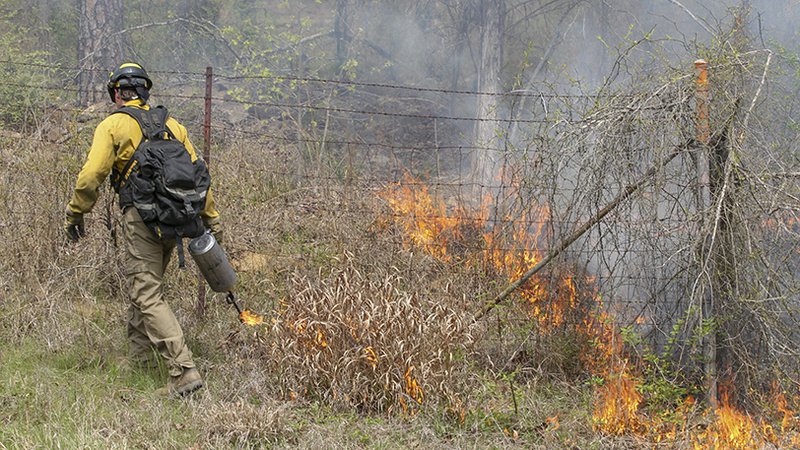Prescribed fire promotes habitat for turkey, quail and other ground-nesting birds
ON 04-17-2019

April 17, 2019
Randy Zellers
Assistant Chief of Communications
LITTLE ROCK — As hen turkeys begin to nest and hunters continue searching for a receptive gobbler, an occasional image is shared throughout coffee shops and social media that causes hunters to cringe – a failed turkey nest sitting in an area cleared with prescribed fire. Controversy surrounding growing-season burns is ignited every year when an outdoors enthusiast happens upon such a site, but improved habitat across thousands of acres creates far more opportunities for nests and brood-rearing than the single nest or two seen after a prescribed fire.
Few and far between
Jeremy Wood, turkey program coordinator for the Arkansas Game and Fish Commission, has spent years in the field researching the direct impacts of prescribed fire during the growing season on nesting wild turkeys, and during his research found the risk of nest loss to prescribed fires is actually very low.
“The majority of research done suggests less than 5 to 6 percent of nest sites could potentially be exposed to fire during the egg laying/incubation period, and the percentage of those nests that fail directly due to fire are even lower,” Wood said. “I won’t say a turkey nest has never failed due to fire, but the number of nests that get burned is not enough to impact turkey populations locally or statewide in Arkansas.”
Areas being burned often have very low chances of exposing nests to fire because they simply are not areas hen turkeys prefer to place their nests any longer. Woody cover has grown too thick to enable turkeys and their poults to see and escape predators. The insect-attracting vegetation that offers poults the bugging ground they need has been replaced with other plants too tall to offer insects at the poult’s level. Prescribed fires restore that area’s potential and will increase production over the long term.
“From the year following a burn to about four years post-burn you’ll have very good nesting habitat filled with grasses and low-lying plants that offer cover and food for poults and still enable hens to keep an eye out for predators,” Wood said.
Wood’s research for his Master’s thesis noted only 6 percent of the turkey nests he located and monitored would have been exposed to fire had the nest still been active at the time of the event. And in those cases, the nests failed because of nest predators or hens abandoning them before any fire occurred.
“Zero of the nests marked in my research failed as a result of fire,” Wood said. “Some may have looked like it because the fire burned away the cover to expose the already failed nest. Without prior knowledge of what happened, a hunter who happens on the scene may assume the nest was destroyed by fire, when in reality predators or some other factor resulted in the loss prior to that fire event ever occurring.”
Small spark on giant landscape
Looking at the big picture of Arkansas’s land and wildlife habitat also reveals the extremely small impact any single fire could have on the state’s overall turkey population. Thousands of acres being burned each year sounds significant, until you compare it to the more than 34 million acres available in the state. Randy Brents, prescribed fire manager for the AGFC’s habitat program, says anywhere from 7,000 to 25,000 acres of the 380,000+ acres the AGFC manages has seen prescribed fire in each of the last five years. Poor weather conditions can impact the amount of acreage burned each spring, but as a rule, the AGFC completes its dormant-season burns prior to the beginning of April, before peak egg-laying and incubation periods for turkeys and other ground-nesting birds.
“Even with the huge amount of public land the Forest Service maintains in Arkansas, it’s really a small percentage of the landscape of Arkansas,” Brents said. “Only 10 percent of Arkansas is public land, and a very small percentage of that can be enhanced with prescribed fire each year.”
Wood agrees, pointing out that the current decline in turkey populations is impacting private and public land, and is occurring in many states, not only Arkansas.
Second Chances
Even when a hen’s nest is abandoned or destroyed, turkey hens have the ability to renest which can mitigate against the loss of an early nest.
“Hens that lose a nest during egg-laying or incubation show a high affinity for renesting,” Wood said. “A substantial percentage of hens that lose their first nest will attempt to renest and pull off a clutch. The condition of the habitat she has available for nesting can play a large role in her ability to avoid predators long enough to lay, hatch and raise those poults. Prescribed fire improves these conditions, and without it, quality nesting and brood-rearing habitat can be lost quickly ”
Visit www.fs.usda.gov/detail/ouachita/news-events/?cid=FSEPRD621963 for information on prescribed fire from the Ouachita and Ozark-St. Francis National Forests. The National Wild Turkey Federation also endorses the use of prescribed fire to benefit turkey habitat. Their information on the topic is available at www.nwtf.org/conservation/article/prescribed-fire-letter
Recent News
Subscribe to Our Weekly Newsletter E-mails
Don’t miss another issue. Sign up now to receive the AGFC Wildlife Weekly Newsletter in your mailbox every Wednesday afternoon (Waterfowl Reports are published weekly during waterfowl season and periodically outside the season). Fishing Reports arrive on Thursdays. Fill in the following fields and hit submit. Thanks, and welcome!


